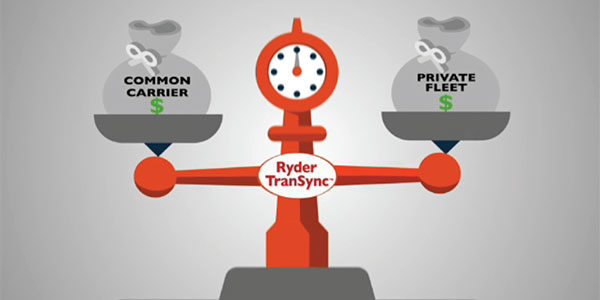Mix and match … with a little high-tech help

Large truck shippers that mostly rely on private fleets, dedicated contract carriage, or a combination of both to meet their obligations have discovered in the past few years a need to supplement those services with for-hire common carriage. However, they've found it difficult to decide which shipments to assign to their private and dedicated trucks and which should be booked with common carriers, which unlike their counterparts have dynamic and unpredictable capacity availability.
What's more, there is a dearth of software that can help do the job because algorithms in the software do not account for factors other than cost that influence the decision to use common carriage, such as driver availability. As a result, shippers are left to perform manual analyses before integrating common carriers into their evaluations, a time-consuming process that cannot be updated easily and thus doesn't accurately reflect current market conditions.
That was the scenario guiding Ryder System Inc.'s development of a tool called "TranSync," which was rolled out in late June after more than a year on the drawing board. TranSync is touted by Miami-based Ryder as the first technology to allow shippers to better mix and match their private, contract, and common carriage and to do it in real time if necessary. If the tool works as Ryder hopes, shippers will do a superior job of controlling their equipment capacity, improve their resource utilization, and offset the challenge of securing drivers, rigs, and trailers. Plus, they will be spared the need to overdeploy equipment as a hedge against problems arising from clouded visibility into their ongoing capacity requirements.
The TranSync tool is not designed to supplant private and dedicated fleets, which have gained in popularity as shippers seek capacity assurance and stability; private and dedicated equipment accounted for 46.4 percent of total truck tonnage in 2012, up from around 40 percent prior to the 2007-09 recession, according to the U.S. Census Bureau. Rather, TranSync is designed to help fleet managers make better-informed decisions about their overall fleet mix and how to optimize the resources at their disposal during what many expect to be a prolonged period of resource shortages, Ryder said.
The TranSync tool "analyzes the best combination of transportation modes at the lowest total network cost, in real time, load by load, every day," Ryder said in its June 23 announcement. Up until now, fleet owners and managers would rely on spreadsheets to determine, as best they could, an optimal real-time fleet mix.
"There is a misconception in the industry that you can identify the lowest total network cost based on optimizing lane rates," John Diez, president of Ryder's Dedicated Transportation Solutions unit, said at the time. The TranSync tool enables Ryder to consider other factors—such as available drivers, fixed fleet costs, and backhauls—and calculate the lowest network costs and optimal resource allocation, Diez added.
In an interview in late July, Diez said Ryder doesn't expect TranSync users to make daily fleet adjustments, although the tool is capable of performing along those lines. But it will be a marked improvement for shippers using manual processes who may tinker with their resource needs "once or twice a year," he said.
A YEAR IN THE PLANNINGThe idea that led to TranSync's creation took root in the first half of 2014 when Ryder, which has its hand in virtually every part of the U.S. trucking pie, found that its shipper customers wanted to incorporate more common carriage into their fleet planning but lacked the technology needed to make reliable shipment-allocation decisions. It asked researchers at the University of Tennessee's Haslam College of Business to build a preliminary mathematical model and then conduct a survey of shippers to determine if a need existed and if such a resource-allocation tool would be useful. The study, conducted between July and September of last year, returned 101 responses across multiple verticals, with 63 percent representing companies with $3 billion or more in annual sales.
Of the total respondents, 74 percent said their companies used a mix of private/dedicated assets and common carriers for their outbound shipments. About 73 percent of the companies had a "defined, specific process" for allocating shipments between dedicated/contract and common carrier resources. However, only 28 percent had a fully automated process in place to assign shipments, while 52 percent were still doing it through manual processes and the remaining 20 percent used a combination. Though most respondents said they were satisfied with the status quo, the data points indicated that the group thought there was significant room for improvement, according to the survey.
The researchers wrote that the "manner in which the hybrid strategy is created and implemented represents a distinct opportunity" for companies that can come to market with an automated process to effectively balance internal and outside equipment use. The benefits of addressing the information gap are "only heightened in a trucking industry strained by increasing costs and customer service requirements in an environment with capacity constraints," they added.
Diez said TranSync is used as part of Ryder's transportation management program, and the company does not position it as a software solution. A user would need to have at least $10 million in common carrier spend to generate value from the tool, he added. TranSync's deployment is too new to quantify its effectiveness, Diez said. The tool will not be available on a standalone basis and will be incorporated into Ryder's existing fleet management relationships. "There has to be some type of affiliation (with Ryder)," he said.
It's a near-certainty that private fleets will save money with an intelligently designed and properly applied vehicle routing program. What is less apparent, though perhaps just as relevant in today's tight supply environment, is a technology's ability to help fleets to leverage their capacity more efficiently, even if the transportation costs are identical. "I'd rather pay $500 and perform with five trucks and five drivers than pay $500 to perform the same tasks with six trucks and six drivers," said John E. Bell, associate professor of supply chain management at the Haslam College of Business and one of the study's three co-authors. While cost savings are a priority of any fleet management strategy, Bell said, fleet efficiency is a critical secondary objective that "many people miss in the vehicle routing process."
What may also be overlooked is how a relatively modest change can potentially yield outsized results. "The implications are clear; there is ample room for improving the decision-making process on how to allocate shipments and utilize available trucking assets using a combination of internal and external fleets," the study's authors wrote.
Related Articles

Copyright ©2024. All Rights ReservedDesign, CMS, Hosting & Web Development :: ePublishing